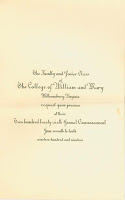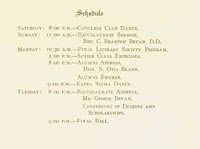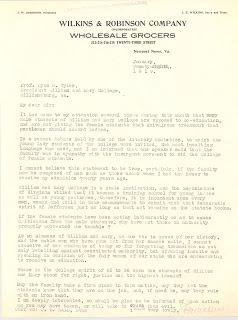 Commencement activities at the College of William and Mary in 1919 were similar to those 90 years later in that events were held over the course of several days from June 7-10th and featured a mix of ceremony and entertainment for the graduates.
Commencement activities at the College of William and Mary in 1919 were similar to those 90 years later in that events were held over the course of several days from June 7-10th and featured a mix of ceremony and entertainment for the graduates.Activities began on Saturday, June 7th, with the Cotillion Club Dance in the evening. Sunday morning there was a Baccalaurate (sic) Sermon by Rev. C. Braxton Bryan, D.D. Activities continued on Monday with the Final Literary Society Program in the morning, Senior Class Exercises in the afternoon, the Alumni Address and the Alumni Smoker in the evening, with another dance - this time the Kappa Sigma Dance - closing out the evening.
Among the oldest records of student organizations at the College of William and Mary are those from the various literary societies, of which William and Mary had several. These societies, which were popular all over the country in the late eighteenth through the twentieth centuries, sought to train their members in public speaking by sponsoring debates and dramatic readings. Some also assigned their members to write essays, which were then critiqued. While the Special Collections Research Center does not have a complete set of records from all of the literary societies, substantial quantities of these records do exist, including nineteenth and twentieth- century minute books, constitutions, by-laws, membership lists, and treasurer's books. The Phoenix and Philomathean Societies, although not the oldest groups, were the longest lived and therefore more material exists for them including from the early twentieth century.
The Hon.
 Schuyler Otis Bland attended the College of William and Mary and in 1919, when he gave the Alumni Address to the soon-to-be-minted newest alumni, was still a new member of the U.S. House of Representatives, having been elected as a Democrat to the Sixty-fifth Congress in 1918 to fill the vacancy caused by the death of Rep. William A. Jones. Bland was reelected to the Sixty-sixth and to the fifteen succeeding Congresses and served until his death in 1950. Bland's personal papers are part of the Special Collections Research Center's collections and available for public use in Swem Library.
Schuyler Otis Bland attended the College of William and Mary and in 1919, when he gave the Alumni Address to the soon-to-be-minted newest alumni, was still a new member of the U.S. House of Representatives, having been elected as a Democrat to the Sixty-fifth Congress in 1918 to fill the vacancy caused by the death of Rep. William A. Jones. Bland was reelected to the Sixty-sixth and to the fifteen succeeding Congresses and served until his death in 1950. Bland's personal papers are part of the Special Collections Research Center's collections and available for public use in Swem Library.For additional information about the first women students at the College of William and Mary see: When Mary Entered with her Brother William: Women at the College of William and Mary, 1918-1945 by Laura F. Parrish; "The Petticoat Invasion": Women at the College of William and Mary, 1918-1945; The Martha Barksdale Papers; and the Women at the College of William and Mary page on the Special Collections Research Center Wiki.



